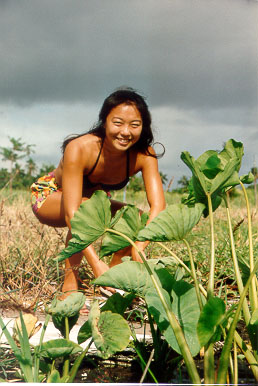|
Poi is the food that Polynesians lived on for thousands of years. Nutrition-wise it is a fairly complete meal for an active
person. It is a very high quality carbo.
The best part for Ultimate players is that it is so easy. All you need is
a source of drinking water. You buy the poi in a bag (about $4 at grocery stores) and toss it in your backpack (although better
fresh and kept coolish, it keeps for days without refrigeration).
When you're ready to eat, just add water to the
bag and mush it around. (Poi can be eaten with any amount of water. More water makes it less "dry" tasting, but
if you make it too runny you'll need a spoon. Ideal mix is about 50-50, which gives you "two-finger" poi.) To serve,
just squish it out into your disc. Eat with your fingers.

Tomoe helped with concessions my first year with the Kaimana Klassic (a tournament in Feb put on by HULA). Here she is harvesting
taro leaves.
|
|
Laulau
This one has to be kept refrigerated (it's cooked meat), but is a great combo with the poi. It has vegetables
(taro leaf, looks like spinach but tastes far better) and meat (usually pork, also chicken). At home we just toss the laulau
into the microwave for a few minutes and serve with a big bowl of poi. To eat, unwrap the outer leaves (ti, not to be eaten),
and break the bundle apart. There are two funny things inside besides the leaf and meat. Both are about the size of a die.
There's a cube of pork fat for flavor (could be eaten but can gag you), and a cube of butterfish (a tasty salty fish, do eat).
Usually sold in the meat department of a grocery store. They're precooked. Some deli's have them hot and ready to eat. (You
can also get as a "plate lunch" at local diners.)
Kulolo and Haupia
To complete your little instant luau (if you have the poi and laulau above), you'll need a good
Hawaiian desert. Both of these are about $5 in the deli. Kulolo is about the size of a stick of butter, and looks brownish.
It's a sticky mix of taro, brown sugar, and coconut. Does not need refrigeration. To serve cut into little pieces. It has
a mild, subtle flavor that most people like. Haupia is basically coconut pudding. Looks like white brownies. It tends to be
chilled at least, but I don't think you'll die if it's not. And if you can't find one of these, just go pick some coconuts
and make your own. (Just kidding, that is quite a production.)
Let's get you some of our tasty tropical fruits.
Most of the banana trees you'll see in people's yards are
"apple" bananas (also called Brazilian bananas). Apple bananas are smallish and have a little nub on the end. You
can find them in the stores for just a little more than standard bananas. Good flavor.
Lychee will be a little out of season when you're here in August. Most are ripe in May, and there are a few varieties that
get ripe in July and maybe early August. They're a little expensive but a treat.
Papayas very common in August, relatively cheap, and very good. Easy to bruise and tend to be squeezed to death in tourist
traps. Best bought 90% green and ripened a day or two. Most people like them best about 10 - 50% green.
Mangoes are mostly pau (out of season) by early August, but you may find some. The best place to look is Chinatown.
Mangoes are tricky and messy to cut up, but a good mango is probably one of the tastiest fruits you'll have in your entire
life.
If you have nothing but your hands and teeth, you can rip it open and have a few gloriously drippy moments
eating it (hopefully near a place to wash off).
There are a few minor problems with this method. A few people get
a little rash from the skin, so at least don't rub it all over your face the first time. The other problem is mangoes have
strings, and if you scrape the skin and seed with your teeth you'll be wishing you had some floss handy.
The most
civilized way to eat a mango is to cut it up into bite-sized pieces first. A sharp knife and a sharp spoon will help. But
no matter how you eat a mango, it is a tropical delight.
|



